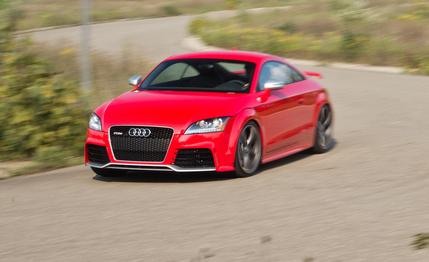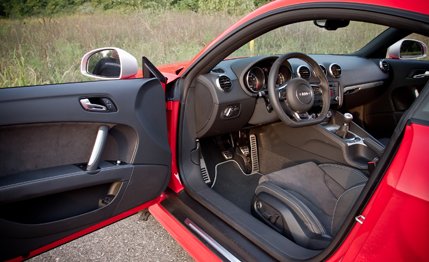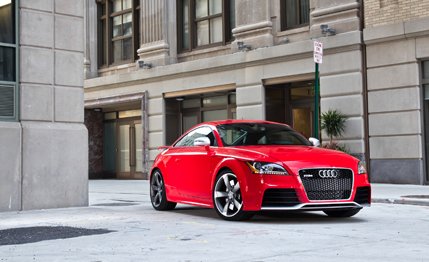 Instrumented Test
Instrumented Test
Last May, we judged an Audi TT RS similar to this one to be a “devastatingly effective single-purpose tool.” We also judged it second-best in a three-way free-for-all versus an Infiniti IPL G37 and a (winning) BMW 1-series M coupe.
The similarity in this case is rooted in power delivery. In the comparo car, thrust was vectored via a seven-speed dual-clutch automatic whose function, like that of other Audi S tronic gearboxes, was brilliant.
But you can’t buy an S tronic TT RS in this country. American-spec cars come only with a six-speed manual. Is this a bad thing? That’s what we’re here to find out.
The do-it-yourself tranny is an exemplary “Save the Manuals!” unit: crisp gear engagements, short throws, sweet clutch. More important, it reinforces the sense of man-machine connectivity.

Sad to say, though, it’s not the optimal device for extracting maximum go from Audi’s formidable 2.5-liter, direct-injection turbo fünf (360 horsepower, 343 pound-feet of torque). The combination of the S tronic and launch control yielded a 0-to-60-mph sprint of 3.6 seconds in the car we tested for the comparo, which carried the old 335-hp Euro-spec motor. The best we managed with the manual six-speed was 4.0.
What this demonstrates is the advantage of a dual-clutch automatic—its gears are never completely disengaged, its shifts are instantaneous, and power delivery is never interrupted. Launch control helps, but a key difference between a manual and an automatic transmission is the manual’s brief accelerative pause during each upshift.

Still, four seconds doesn’t leave a lot of time for admiring the scenery. That 4.0 sprint is a half-second quicker than our May forecast for the manual model, a tenth quicker than Audi’s official forecast, a half-second quicker than the 1-series M Bimmer, and just a tenth slower than the BMW M3 that topped a September 2010 comparison.
So, slower but far from slow. How about the other demerit for that May TT: “The TT RS is so competent,” we reported, “so coldly immune to human clumsiness as to diminish the role of the driver.”
It’s true that the Audi tracks like a slot car and that it would take extraordinarily bad judgment to provoke disaster. It’s true that its combination of grip (0.96 g) and all-wheel drive pretty much eliminates scary stuff like oversteer. And it’s true that only ordinary skills are required to take the TT RS to its absolute limits, ultimately defined by progressive understeer.
But those limits are very high indeed. So if you’re negotiating a series of high-speed turns, is it better to have absolute certainty about the car’s dynamics? Consider a track-day environment. In low- to medium-speed corners, a little tail-wagging can be titillating. But in really fast ones—for example, the infamous Kink at Road America—oversteer is a peril few would court.

Other demerits for this TT RS are consistent with those of its S tronic counterpart. Seductive as it is in short bursts, the optional sport exhaust system ($1500) can become tedious in extended driving. The seats, though supportive, aren’t quite up to BMW standards, while the rear seats are basically unusable for adults.
Neither is price the car’s most endearing feature. With the sport exhaust, an aluminum trim package ($950), and red pearl paint ($475), the $60,650 as-tested total is almost 10 grand more than the 1-series M that prevailed in May. Unfortunately, 1-series M production ceased in October.
As for diminishing the role of the driver, it’s fair to say that the manual transmission mitigates this aspect of our earlier indictment. It’s also fair to say that for some, the ability to drive quicker than ever before will be enough, whether or not their skills have actually improved.